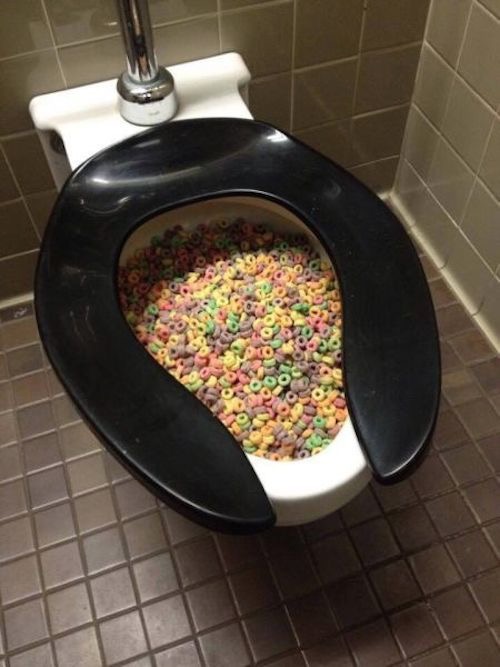Is it Acceptable to Flush Food in the Toilet?
Is it Acceptable to Flush Food in the Toilet?
Blog Article
We've stumbled upon the article about Think Twice Before Flushing Food Down Your Toilet down the page on the internet and decided it made sense to relate it with you here.

Intro
Many individuals are usually faced with the problem of what to do with food waste, particularly when it involves leftovers or scraps. One usual question that arises is whether it's fine to purge food down the bathroom. In this short article, we'll delve into the reasons individuals may consider flushing food, the consequences of doing so, and alternate approaches for appropriate disposal.
Reasons why people might take into consideration flushing food
Absence of awareness
Some individuals might not be aware of the potential injury brought on by purging food down the commode. They may wrongly think that it's a safe method.
Ease
Purging food down the toilet may look like a quick and very easy service to getting rid of undesirable scraps, especially when there's no nearby trash can available.
Idleness
Sometimes, people may just choose to flush food out of large idleness, without considering the consequences of their actions.
Consequences of flushing food down the commode
Ecological influence
Food waste that ends up in waterways can contribute to pollution and harm marine communities. Furthermore, the water used to flush food can strain water resources.
Pipes problems
Flushing food can cause clogged up pipelines and drains, triggering pricey pipes repairs and hassles.
Sorts of food that need to not be purged
Fibrous foods
Foods with fibrous structures such as celery or corn husks can get entangled in pipes and cause clogs.
Starchy foods
Starchy foods like pasta and rice can soak up water and swell, bring about blockages in pipelines.
Oils and fats
Greasy foods like bacon or cooking oils must never be purged down the toilet as they can strengthen and trigger clogs.
Proper disposal techniques for food waste
Using a waste disposal unit
For homes geared up with waste disposal unit, food scraps can be ground up and flushed via the pipes system. Nevertheless, not all foods appropriate for disposal in this manner.
Recycling
Specific food product packaging materials can be recycled, minimizing waste and reducing ecological impact.
Composting
Composting is a green way to get rid of food waste. Organic products can be composted and made use of to improve soil for gardening.
The significance of proper waste management
Reducing environmental injury
Appropriate waste administration methods, such as composting and recycling, help minimize air pollution and maintain natural resources for future generations.
Shielding pipes systems
By preventing the practice of flushing food down the commode, house owners can prevent pricey plumbing repair work and maintain the honesty of their pipes systems.
Verdict
To conclude, while it might be appealing to flush food down the commode for comfort, it is necessary to understand the potential consequences of this activity. By taking on correct waste administration techniques and throwing away food waste responsibly, individuals can add to healthier plumbing systems and a cleaner setting for all.
THINK TWICE BEFORE FLUSHING FOOD DOWN YOUR TOILET IN FALLBROOK CA
Let’s be honest, we’re really supposed to be tossing rotten or leftover food in the compost bin or trash can. But many people like to place scraps of food down the drain of, say, their kitchen sink. That’s why the garbage disposal was invented: so we can continue to place certain foods down the drain without clogging our drain in the process. Smart.
But not all of us have the luxury of having a garbage disposal installed. So, you might continue to shove food down your sink drain anyway – or worse: you might flush them down your toilet! If you’re guilty of doing the latter, you’re going to want to stop, and here’s why:
Toilet Drains Aren’t Designed to Handle Food!
There’s your answer: food just doesn’t belong in your toilet. It may seem like your toilet drain is wider than the drains of your sinks, but truth be told, that isn’t actually the case. The narrower pipes of your toilet leave your plumbing at risk for clogging if you do happen to flush your food. In addition, food doesn’t break down as quickly that toilet paper and human waste do. In turn, this leaves your toilet at risk for a nasty clog.
Although a flush of a tiny pinch of food every now and then isn’t going to completely damage your toilet, there are certain foods that should absolutely not be flushed in your toilet at all. These include starchy foods like mashed potatoes, grains, hard pieces of food that are slow to break down, and fats and oils.
The latter categories of food are particularly problematic as they may harden, expand as they absorb water, break down slowly in your system, or generally create the perfect obstruction with their gelatinous composition. These are all things you don’t want in your plumbing system!
Experiencing a Toilet Clog?
Nobody’s perfect, and we all make mistakes. Sometimes one of the mistakes people make is flushing food down their toilet and later realizing that it wasn’t the best thing to do once they see that their toilet is now clogged. Uh-oh!

I was made aware of that write-up about Think Twice Before Flushing Food Down Your Toilet through someone on a different site. Liked our blog posting? Please quickly share it. Let another person check it out. Thanks a bunch for your time. Revisit us soon.
Apply Now Report this page